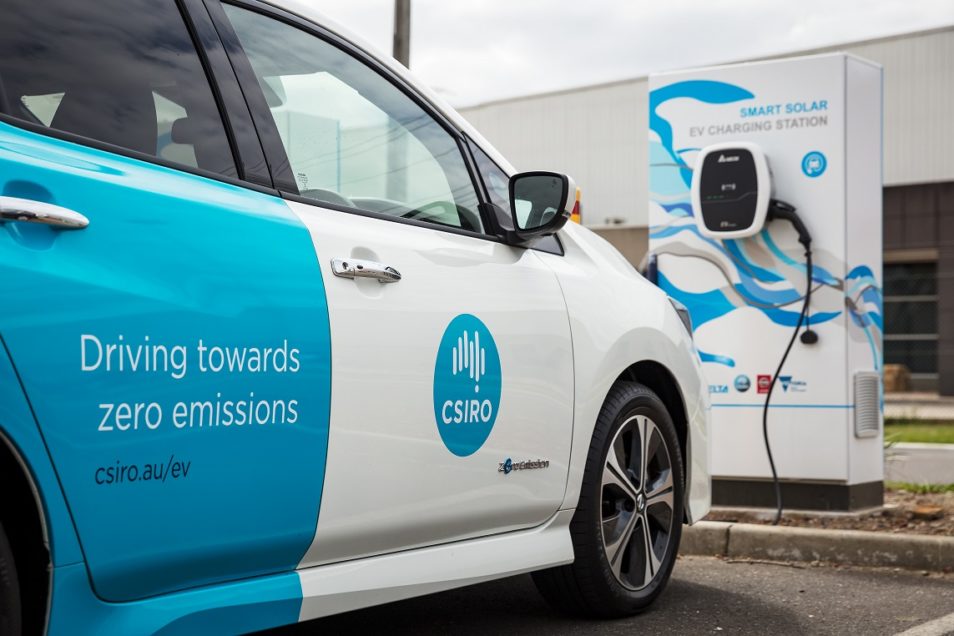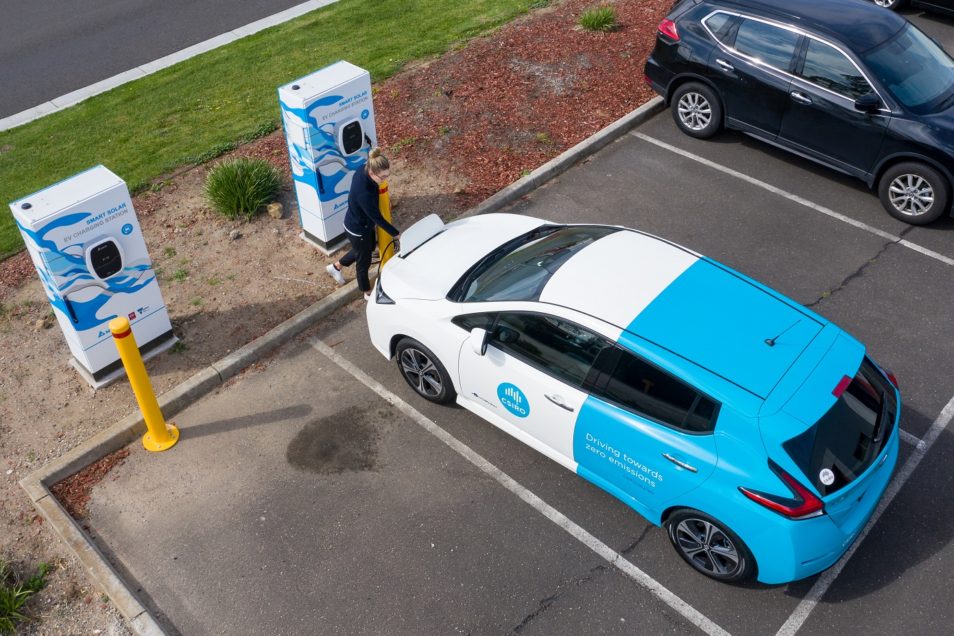
Solar panels on the building power the charging modules, which also contain a battery and our smart charging technology.
You’re cruising home after a long day at work. The orange fuel light starts blinking. It’s your car reminding you there’s only 20km left in the tank.
Traditionally, your next step would be to manoeuvre through peak hour traffic, sigh inwardly at the advertised fuel price, fill up and then be on your way… only to do it all again two weeks later. But with electric vehicles (EVs) gaining traction, this routine will change. Our new technology can help make this process even greener.
Electric vehicles plugging into solar
It’s new, it’s exciting. It’s solar-powered electric vehicle charging. This new system links your rooftop solar with a battery system and smart technology to manage the way your car is charged. Plus, it’s designed with the Australian household in mind.
There are many benefits to this system, which we’ll explain further below.
- You can power your car with home-grown renewable energy, which can also be stored for when it’s needed most.
- CSIRO-developed smart technology decides when to draw from solar, battery, or the electricity grid when your car is charging.
- You can reliably charge more than one electric vehicle at a time.
- Charging your electric vehicle in the height of summer is no sweat.

With renewable-powered charging technology, we really are driving towards zero emissions.
Clean, mean driving machine
Transport is Australia’s third-largest source of greenhouse gas emissions. And it’s increasing faster than in any other sector. Electric vehicles can make a huge impact here. They’re a cleaner option, even from using only grid power. But instead of using grid power, it makes sense we start using the power generated from Australia’s two million+ homes with solar photovoltaic panels.
You can store the solar energy you collect during the day in a household lithium-ion battery. This allows you to stash the energy away for later in the day when you plug your electric vehicle back in.
Our EV researcher Dr Christopher Munnings has done the maths and the argument for solar-powered charging stacks up. He said it’s a prime example of what’s called a ‘hybrid system.’ There we use multiple solutions (solar, battery, electric vehicle) for a positive result (lower emissions from transport). This is the type of research Chris performs in our Centre for Hybrid Energy Systems.
“Once you’re charging on renewables, the argument is pretty clear. An EV will emit less CO₂ over its lifetime than a regular internal combustion engine. If you recycle or reuse your batteries the numbers get even better,” Chris said.

It’s as easy as ‘point and shoot’, and overnight charging will become second nature.
Home is where the charge is
For most electric vehicle users, around 90 per cent of charging will be at home, meaning no peak hour detours to the servo. You’d likely go home as normal, plug the car in, and not think twice until you come back in the morning. Then your car will be charged and ready to roll – just like our mobile phones.
Australian city-dwellers drive an average of 30-40 km each day. Modern electric vehicles have a range over 250km. So, depending on your driving habits you may only need to charge an electric vehicle once or twice a week. After a while, it will become second nature to plug in daily.
What happens if we’re all charging our electric vehicles at once?
It’s possible the electricity grid could become stressed from the demand as more of us plug in our EVs each evening. This could be compounded during warm weather when the grid is under the most strain.
It’s also possible your household would want to charge more than one EV at a time with a standard grid connection. If this is the case, you’ll struggle to have enough spare power to run anything else. Like your air-conditioner, hairdryer and popcorn machine. You know, the essentials.
We’ve developed a new technology that controls when to charge your car, how quickly, and from which source (solar/battery/grid). It can also multi-task by charging up to four vehicles at a time. This is great for locations with limited grid connection, like at home, a shopping centre, or somewhere remote. This means a stress-free evening without having to reset fuses. It’s also great for the grid, which gets a smoother ride with no dramatic increases in power demand.

Our Senior Researcher Dr Christopher Munnings is plugged into all things ‘electric vehicles’.
Summertime solutions
Our electricity grid isn’t the only concern in warm weather. Often, battery systems can be less effective when the weather’s hot. When you need your car completely charged, this can quickly become an issue.
Our EV expert Chris said: “A normal household battery system is typically not powerful enough to charge a car on a hot day as it can overheat and slow down.”
“Our solar charging system can manage the temperature of the battery, minimising the amount of power required from the grid.”
“In a multi-EV home, this system will automatically monitor each car, spreading the load between the battery, solar PV and the rest of the home. This means the cars charge as quickly as possible, using as much sun as possible, without the need to upgrade grid connection.”
How do we know it works? We helped put the systems through their paces by installing three solar charging modules at Nissan Headquarters in Dandenong. Each module is capable of charging four vehicles at a time. They’ll be evaluated over 200 days, including the peak summer period. We look forward to reporting back and sharing what’s next for this exciting tech.
The project was funded by the Victorian Government and undertaken in collaboration with Delta Electronics and Nissan. Our researchers developed and tested the system and implemented the thermal management controls.


20th November 2019 at 10:45 am
Electricity is a relatively mobile commodity. I’d like to see a system where you can tap into your own generation remotely so you are renting the infrastructure service delivery but using your own power. This probably wouldn’t work if electricity was only a small part of the cost but I’d like to see it explored. It would allow you to charge using your own power anywhere.
20th November 2019 at 10:39 am
Electricity powering transportation is nothing new. Trams and electric trains move the masses. But battery operated- they always suffered from easy adoption. Battery is a leaky jerry can! Petrol never needed the ‘push’ (businesso-political) like the battery operated vehicles. It was adopted without question- it worked. In every nook and crevice of the world. The internal combustion engine could be reproduced in various sizes and forms. It transformed nations. As much as I wish to have an alternative, I do not to vilify that technology. It was and is, a marvel of human ingenuity. My reluctance in moving to electric stems from my lack of trust in two entities- people that produce and distribute electricity and people that run IT systems. These laptops on wheels could be sapping the last vestiges of human freedom that is left! Not that I trust petrol manufacturers- it’s all relative 🙂 food for thought.
20th November 2019 at 10:34 am
Very keen on the idea of recycling used ev batteries as a storage device for our house but not sure whether Ergon, which we are contracted to sell our solar power to until 2028, would allow. Please keep me informed as to when this might be an option.
Do you have a figure for how much air conditioner use reduces the range of an ev? Vehicle air con in the tropics is pretty much on all year.
20th November 2019 at 10:10 am
The current technology will likely change – and the specific needs of people like Peter (not just wheel chair bound, but elderly etc) will morph again with autonomous vehicles. Loop charging sounds like a possible solution, but trials been undertaken by CSIRO, car manufacturers and others bring out the real world issue. I think the uptake will gradually build – maybe quicker than I think – but lets hope technology doesnt over run the ability for infrastructure to cater for it. If every house went to EV in 5 years for example I am sure we would have major energy network infrastructure issues with supply issues galore – the last thing we want is another “pink bats” fiasco
22nd October 2019 at 8:46 am
The link to “we’ve developed a new technology” is broken. The article doesn’t really describe what you’re doing. Existing battery technologies (i.e. Tesla’s Powerwall and their BMU) already supports charging electric cars and balancing load between energy sources and works fine in Australian weather.